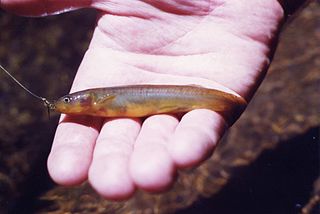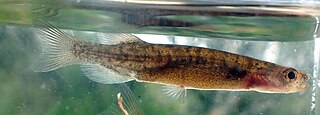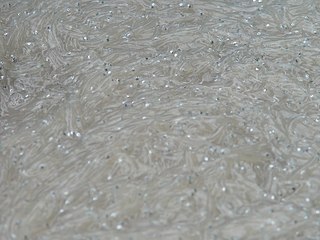
The Galaxiidae are a family of mostly small freshwater fish in the Southern Hemisphere. The majority live in Southern Australia or New Zealand, but some are found in South Africa, southern South America, Lord Howe Island, New Caledonia, and the Falkland Islands. One galaxiid species, the common galaxias, is probably the most widely naturally distributed freshwater fish in the Southern Hemisphere. They are coolwater species, found in temperate latitudes, with only one species known from subtropical habitats. Many specialise in living in cold, high-altitude upland rivers, streams, and lakes.

The climbing galaxias or kōaro is a fish of the family Galaxiidae found in Australia, New Zealand, and nearby islands. The name climbing galaxias is used in Australia, and koaro or kōaro in New Zealand. Further vernacular names include short-finned galaxias, broad-finned galaxias, Cox's mountain galaxias, and Pieman galaxias.

The common galaxias or inanga is a very widespread Southern Hemisphere fish in the family Galaxiidae. It is a slim, narrow fish with a forked tail and a mottled, spotty pattern, typically about 10 cm (4 in) long when fully grown. It lives in fresh water, but spawns at river mouths and spends the first six months of its life at sea, returning en masse in spring. Its vernacular names include cowfish, jollytail, common jollytail, eel gudgeon, inaka, native trout, pulangi, puye, slippery tarki, spotted minnow, Falklands minnow and whitebait.

The Chatham mudfish, formerly known as the Chathams galaxias, is a galaxiid fish endemic to two small, peaty lakes in southern Chatham Island, New Zealand.

The Northland mudfish is a galaxiid of the genus Neochanna, found only in swampy locations west of the Bay of Islands in Northland, New Zealand. Its length is up to 134 mm.

The Canterbury mudfish, also known as the kowaro, is found only on the Canterbury Plains in New Zealand. Like other Neochanna species, it is a small, tubular and flexible fish which lacks scales. They are able to survive out of water in damp refuges if its wetland habitat dries out periodically over summer.

The waikaka or black mudfish is a fish of the family Galaxiidae, found only in swamps and wetlands in the northern half of the North Island of New Zealand, from Kaitaia in the north to the Mokau River in the south.

The brown mudfish is a galaxiid endemic to New Zealand. The species is found in wetlands in the southwest of the North Island and the northern half of the west coast of the South Island. It commonly grows to 100–130 mm in length, and it can live to at least 7 years. They are named for their brown color.

The Tasmanian mudfish, Neochanna cleaveri, is a small Australian amphidromous fish in the galaxiid family, of the order Osmeriformes.

The banded kōkopu is a galaxiid of the genus Galaxias, found only in New Zealand, including the Chatham and Stewart/Rakiura islands. It commonly grows to 20–25 cm, but has been recorded growing to around 30 cm. Juvenile banded kōkopu are good climbers and can climb up waterfalls and other vertical surfaces by moving into the splash zone and wriggling up the surface, using the water surface tension and their large downturned fins for grip.

The shortjaw kōkopu is a galaxiid fish, endemic to New Zealand. They are large, scaleless fish which inhabit stable pools in cascading, bouldery streams with forest cover. Shortjaw kōkopu are amphidromous, with the fry going to sea after hatching, and returning as juveniles to fresh water where they grow to adulthood. They may grow to a maximum of 350 mm (14 in) in total length, but more commonly reach 150–200 mm (5.9–7.9 in).

The giant kōkopu is a threatened species of ray-finned fish in the genus Galaxias, found only in New Zealand. It can reach up to 58 cm (23 in) in length and 2.7 kg (6.0 lb) in weight, making it the largest species in the family Galaxiidae. It is a mainly lowland species, commonly found in slow-flowing streams, wetlands, lakes, and lagoons. Most populations have an amphidromous life cycle, with larvae going to sea soon after hatching and returning about four months later as small juveniles, 4.5–5 cm (1.8–2.0 in). Juvenile giant kōkopu form a small part of the annual whitebait catch.

The dwarf inanga is a galaxiid of the genus Galaxias, found in the North Island of New Zealand.

Eldon's galaxias is an endangered galaxiid fish endemic to New Zealand. One of several fishes in the genus Galaxias found in Central Otago, it has a very small home range and is at risk of being driven to extinction by trout introduced for recreational fishing.
Gollum galaxias is a galaxiid of the genus Galaxias, found only in southern temperate regions in New Zealand. The species is widespread in rivers throughout the Southland Plains as well as the Von River and Nevis River tributaries of the Clutha River The species is found on Stewart Island/Rakiura, and throughout the Catlins.

The torrentfish, or panoko (Māori), is an amphidromous freshwater fish that is endemic to New Zealand. Torrentfish are well adapted to life in shallow, fast-flowing riffles and rapids. They grow to a maximum of 20 cm (7.9 in) in total length, but more commonly reach 10–12 cm (3.9–4.7 in).

Gerald Stokell was a New Zealand amateur ichthyologist.

Whitebait is a collective term for the immature fry of fish, typically between 25 and 50 millimetres long. Such young fish often travel together in schools along coasts, and move into estuaries and sometimes up rivers where they can be easily caught using fine-meshed fishing nets. Whitebaiting is the activity of catching whitebait.

The Whangamarino Wetland in the Waikato District is the second largest wetland complex of the North Island of New Zealand. Encompassing a total area of more than 7200 hectares, the Department of Conservation Te Papa Atawhai manages 5,923 hectares of peat bog, swamp, mesotrophic lags, open water and river systems listed as a wetland of international importance under the Ramsar Convention. Fish and Game New Zealand are the second largest landowner, managing 748 hectares of the wetland primarily as gamebird hunting habitat.

The Golden galaxias is an endangered species of landlocked galaxiid fish belonging to the genus Galaxias. It is endemic to Lakes Crescent, Sorell, and their associated waterways located in central Tasmania, Australia.




















